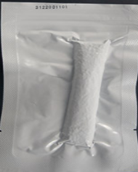CGI DRYING TRAPS
(For maintaining anhydrous conditions in water-free solvents and reagents)
CGI Drying traps are used for maintaining moisture-free environments in oligonucleotide synthesis. The use of these traps will generate super anhydrous conditions for high-quality full-length DNA/RNA.
- The Drying traps are available in four different sizes: Small, Medium, Large, and Extra Large.
- The Drying traps are shipped fully activated in vacuum sealed foil packets and are ready for immediate use.
- These traps allow highly effective drying of either phosphoramidite solution in acetonitrile, tetrazole solution in acetonitrile or anhydrous acetonitrile.
- In addition, the use of these traps in the acetonitrile bottles wash cycle in the DNA synthesizer will maintain a dry environment which results in consistently high coupling in the synthesis per cycle.
Please see the data in the chart below for the selection of your specific application. As the chart indicates a small trap should be used for 10 ml acetonitrile solution and a large trap should be used for 4000 ml acetonitrile solution.
Selection Guide for Bottle Size and Solvent Volume
| Size |
Quantity of Acetonitrile |
Catalog # |
Pics |
Approximate Dimensions (mm) |
Inner bottle neck Diameter |
| Small /2 gm |
10-50ml |
CGIDT-01 |
 |
10X30 |
12 mm |
| Medium /5g |
50-100ml |
CGIDT-02 |
 |
15x85 |
17mm |
| Large /10g |
1000-2500ml |
CGIDT-03 |
 |
22x85 |
28mm |
| Extra-large/20g |
4000ml |
CGIDT-04 |
 |
22x135 |
24mm |
Efficiency in Moisture Absorption
The Drying Trap is vacuum-packed, and it needs to be opened even if it is used, and the seal of the reagent bottle must be ensured during use. Below the water absorption of the traps of different sizes, as determined by coulometric analysis of acetonitrile spiked with water.
| Quantity of Acetonitrile |
Amount of Moisture present in wet solvent |
Number to Traps required |
Size of trap |
Time required |
Achieved |
| 10-50ml |
180-200ppm |
One |
Small /2g |
24 Hours |
35-40ppm or lower |
| 50-100ml |
180-200ppm |
One |
Medium/5g |
24 Hours |
35-40ppm or lower |
| 0L-2.5L |
180-200ppm |
One |
Large/10g |
24 Hours |
35-40ppm or lower |
| 5L to 4.0L |
180-200ppm |
One |
Extra Large/20g |
24 Hours |
35-40ppm or lower |

Quality Assurance:
The Drying Trap fill has been use tested by quantifying amine removal from commercial sources of solvent. For the customer, product quality is assured by examining the package before use. First, by verifying that the packet vacuum is intact, as any loss of vacuum indicates air entry which would reduce the performance of the product; and second to check for any powder leakage inside the foil packet which would indicate a leak point in the membrane pouch.
Materials:
Drying Trap packets are designed and manufactured to exist long-term, the solvent exposure while maintaining full filtration of particulates. The Drying Traps are made from an inert, micro-porous, electronics grade membrane material. The effective filtration of this membrane is 0.2micron. The membrane material is tested safe for long term exposure to dimethylformamide (DMF) and N-methyl-pyrollidinone (NMP).
Applications Suitability:
Drying Trap packets are designed for use in both solid-phase and solution-phase peptide synthesis. They are safe for use in the wash and reagent bottles of automated peptide synthesizers, and have been functionally tested in most types of commercial synthesizers. Solvent pre-treated with Drying Trap scavenger packets can be safely used to make up Fmoc-Amino Acid solutions. Studies have shown that these solutions can be stored for over a week at room temperature with no detectable loss of the Fmoc functionality.
The Drying Trap is suitable for long-term exposure to nitrile, and may also be used for acetic acid, ether, acetic ether, butyl acetate, alcohol, isopropanol, methanol, butanol, Phenol, pyridine, hydrochloric acid, nitric acid, phosphoric acid, sulfuric acid, methyl chloride, nitrogen methyl imidazole, etc.
Disposal:
Drying Trap scavenger packets are non-hazardous as received. Once used however, they become contaminated with the chemicals and solvents they are exposed to and then should be treated as contaminated waste. Though the dry Trap fill itself is considered non-hazardous and can be disposed of in the normal trash, because of the extreme hydroscopic nature of the Trap fill, care should be taken to avoid tearing the dry membrane pouch as the scavenger dust can be irritating to eyes and mouth.